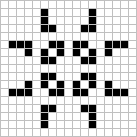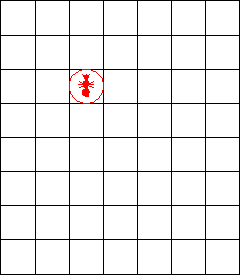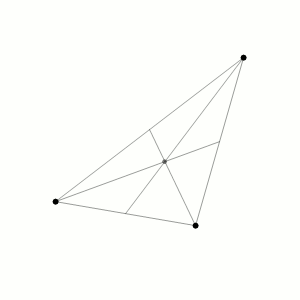Cellular Automata
Moving away from physical simulation
Previously, all our simulations were physical in nature, i.e. we were trying to capture some essence of physics.
However, we can also simulate things which don't directly involve physics.
These are "rules-based" simulations.
For example, many games can be simulated using rules-based simulations.
Stockfish (white) vs GPT-3.5 (black) in the most hilarious game of all time.
Cellular Automata
Cellular Automata
- A very popular type of simulation based on a grid.
- Rules tend to be of the form "if
<condition>is true about neighboring cells, then do<X>. - Observation: very simple rules can lead to complex patterns.

By JohnnyNyquist - File:Ca110-interaction.png, CC BY-SA 3.0, https://commons.wikimedia.org/w/index.php?curid=18642205
One-Dimensional CAs
Cells are in a row. Each cell has two neighbors. The cell's state in the next timestep depends on its current state and its neighbor's states.

We can stack changes in various frames to form 2D images:

Fun Fact
Even one-dimensional cellular automata have universal computing power!
The automata shown is known as "Rule 110". It has been proven that anything that is computable on a "real" computer can also be computed using Rule 110.

By JohnnyNyquist - File:Ca110-interaction.png, CC BY-SA 3.0, https://commons.wikimedia.org/w/index.php?curid=18642205
Conway's Game of Life
Conway's Game of Life
- A two-dimensional CA developed by John Conway in 1970.
- Value of cells defined by values of neighboring cells
- Cells have two states: alive or dead

John Conway, 1937-2020
At each step:
- A cell with <2 neighbors will die, as if by loneliness
- A cell with 2-3 neighbors will survive if it is alive
- A cell with >3 neighbors will die, as if by overpopulation
- A dead cell with exactly 3 neighbors will be born, as if by reproduction
| # Neighbors | Action |
|---|---|
| 0-1 | Die (or stay dead) |
| 2 | Maintain Current |
| 3 | Respawn (or stay alive) |
| more than 3 | Die (or stay dead) |
What happens?
there are other squares out here but they don't matter for these examples
....
....
....
....
| # Neighbors | Action |
|---|---|
| 0-1 | Die (or stay dead) |
| 2 | Maintain Current |
| 3 | Respawn (or stay alive) |
| more than 3 | Die (or stay dead) |
What happens?
| # Neighbors | Action |
|---|---|
| 0-1 | Die (or stay dead) |
| 2 | Maintain Current |
| 3 | Respawn (or stay alive) |
| more than 3 | Die (or stay dead) |
What happens?
The "Pulsar" Oscillator


The "Pentadecathalon" Oscillator
We can even have "pieces" that move around!

Simulating the Game of Life
- Each cell is represented by an integer (0/1) or boolean (true/false) value.
- State of the game is represented by an array of integers
- Apply update rules to each cell to complete a timestep.
How many values do we have to look at to determine the state of each cell in the next timestep?
Where are these values located in the grid?
Does this remind you of a problem we've solved before?
Can we write the new state of a cell directly back to the array? Why or why not?
grid[i, j] = conway_rules(grid, i, j)Autonomous Agents
Agents
Agent-based systems have autonomous agents which sense their environment and act on it. Agents have:
- Environmental input
- Rules for interacting with the environment
- Goals
Even without global structure or understanding, complex behaviors can emerge!
Langton's Ant
Agents are ants on a grid.
At every step, an ant follows these rules:
- Move one grid cell forward
- If pixel is white, make it black and turn right
- If pixel is black, make it white and turn left
Also a universal computer (of course...)

From Wolfram MathWorld
Langton's Ant
Assume ant direction maps to one of the directions/ ints SOUTH (0), EAST (1), NORTH (2), and WEST (3).
What does this code do to the ant?
direction = (direction-1) % 4;
Gridless Autonomous Agents
Flocking
Oftentimes, small flying or swimming animals (birds, insects, fish) will form groups which seem to develop their own movement rules.
However, it is extremely unlikely that all the members are receiving telepathic commands from a leader.


BOIDS
- Separation: try to avoid collisions with local neighbors
- Alignment: try to line up direction with the average direction of local neighbors
- Cohesion: try to move to the average of the local neighbor's positions
A gridless agent-based simulation of flocking which assumes that every member of the flock tries to meet three rules:

- Get current position
- Get position and direction of local flockmates
- Calculate new heading and position based on local neighbor data
- Update position + heading
Example: Predator-Prey
Note: video is from 15 years ago, so quality is a little low
Aside: Local Work!
Neural Cellular Automata
https://github.com/mravelo5874/neural-cellular-automata


CA rules are learned, not prescribed, but this is otherwise just a CA in 3D (voxel) space.
Hands-On: Cellular Automata
Implement a simple version of one of the following:
- Conway's Game of Life. You may need to slow down the framerate for this or things will simulate too fast.
- Langton's Ants. In this case, it may take some time for a complex pattern to emerge.
To help with drawing the grid, you may want to look at drawGrid.pde on Canvas.
Hands-On: Choices
- Conway's Game of Life. You may need to slow down the framerate for this or things will simulate too fast.
- Langton's Ants. In this case, it may take some time for a complex pattern to emerge.
- The mass-spring system from Lecture 12b.
For notecards, please also write subjects you'd like to see covered in our topic classes!
Index Cards!
- Your name and EID.
- One thing that you learned from class today. You are allowed to say "nothing" if you didn't learn anything.
- One question you have about something covered in class today. You may not respond "nothing".
- (Optional) Any other comments/questions/thoughts about today's class.
Is the unsolveability of F=ma something generally accepted, or is there debate over this?


Images from https://en.wikipedia.org/wiki/Three-body_problem
Does shrinking the timestep require processing to do more work vs a larger timestep?
small dt
time
large dt
Computation for physics
Target draw time
Can all this physics stuff be done in Unreal? Or some other software?
Are all (physical) simulations just really complex approximations of real equations?
Pretty much every modern game engine will have some sort of physics simulation code in it.


Yep. Finding out which ones work and which ones don't is a complicated dance of mathematics, computer science, and just trying stuff out to see what works and what doesn't.
How do modern games create such realistic physics? How many points do you need to make realistic cloth?
Tons of work and engineering. Surprisingly, you don't need that many points to make a good cloth, but you need lots of springs.

If I wanted two things to stick together on collision, how would I do that?
General rule for physical simulation: think of some constraint/relation you want your system to satisfy, then use that to write your physics.
What would be a good rule to apply in this case?